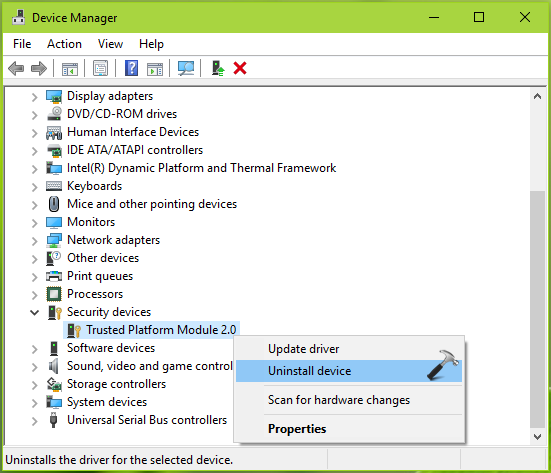

- #NO TRUSTED PLATFORM MODULE WINDOWS 10 HOW TO#
- #NO TRUSTED PLATFORM MODULE WINDOWS 10 UPGRADE#
- #NO TRUSTED PLATFORM MODULE WINDOWS 10 FULL#
- #NO TRUSTED PLATFORM MODULE WINDOWS 10 SOFTWARE#
- #NO TRUSTED PLATFORM MODULE WINDOWS 10 CODE#
If it is supported but disabled in BIOS or UEFI, you’ll see the notification “The TPM is not ready for use.” Unfortunately, if your PC has TPM 1.2, that won’t do as Windows 11 requires TPM 2.0.Īs noted, newer PCs should have TPM 2.0 support. If TPM is not supported, you’ll see the notification “Compatible TPM cannot be found” under Status.
#NO TRUSTED PLATFORM MODULE WINDOWS 10 FULL#
Meanwhile, you can visit the official Microsoft website to check the full list of system specifications required to support Windows 11. The PC Health Check app is currently only available to Windows Insiders, but it will be available to everyone soon. You’ll also be able to see how old your machine is. You’ll see a list of your device’s specifications, including TPM 2.0 if it is enabled on your PC.

If you’re a Windows Insider, Microsoft makes it easy for you to check if your PC is compatible with Windows 11 through the PC Health Check app. There are several ways to check if your PC supports TPM 2.0. TPM is tamper-resistant, making unauthorized access to your files nearly impossible. Put another way, if a hacker steals your drive and plugs it into another computer, they can’t simply decrypt it and access the files without the keys stored in the TPM. The TPM also performs various authorization functions, including drive encryption and secure biometric sign-ins with Windows Hello. In a blog post, Microsoft explains that PCs require this “modern hardware root-of-trust to help protect from common and sophisticated attacks.” The post adds that “requiring the TPM 2.0 elevates the standard for hardware security by requiring that built-in root-of-trust.” Microsoft has made it clear that Windows 11 will only run on computers that have TPM 2.0 capabilities. Think of TPM 2.0 as a security protocol intended to make the life of hackers a little bit harder. If a problem with the key is detected, the PC won’t boot. If everything checks out, the computer will start up.
#NO TRUSTED PLATFORM MODULE WINDOWS 10 CODE#
When you press the power button on your PC, the TPM chip communicates with other security features within the system and supplies a unique code (cryptographic key) that cannot be modified.
#NO TRUSTED PLATFORM MODULE WINDOWS 10 SOFTWARE#
Unlike software security, which is more malleable, hardware security is more effective. TPM 2.0 generates an integrated cryptographic key to protect data used to authenticate your PC. TPM, short for Trusted Platform Module, is a small chip in your PC’s motherboard, whose function is to provide security-related features at the hardware level.
#NO TRUSTED PLATFORM MODULE WINDOWS 10 HOW TO#
In this guide, we lay out everything you need to know about this chip, why you need TPM 2.0 for Windows 11, and how to enable TPM 2.0 on a PC. If you’re getting the error “The PC must support TPM 2.0,” it may mean TPM is currently not enabled on your device. If you bought your PC after 2016, chances are it comes with TPM 2.0 and will support Windows 11. In fact, it seems the company started preparing users for Windows 11 in 2016, when it required TPM 2.0 support on all new computers that ran any version of Windows 10. Microsoft has been strict about this requirement ahead of the system’s official release to the public. Apart from having the usual minimum RAM and storage space, your system must support TPM 2.0.

Your PC must meet specific requirements to be compatible with the new OS.
#NO TRUSTED PLATFORM MODULE WINDOWS 10 UPGRADE#
While the Windows 11 upgrade will be free (as long as you have a genuine license for your current Windows 10 OS), not all devices will support Windows 11. According to Microsoft, some devices may receive the upgrade earlier than others. The official rollout is scheduled to start later this year and continue into 2022. Microsoft has a new and exciting operating system in the pipeline for its users, and you can sign up for the Insider beta program to try it out. Did you run into the “The PC must support TPM 2.0” error when trying to upgrade to Windows 11? If so, then this article is for you.


 0 kommentar(er)
0 kommentar(er)
